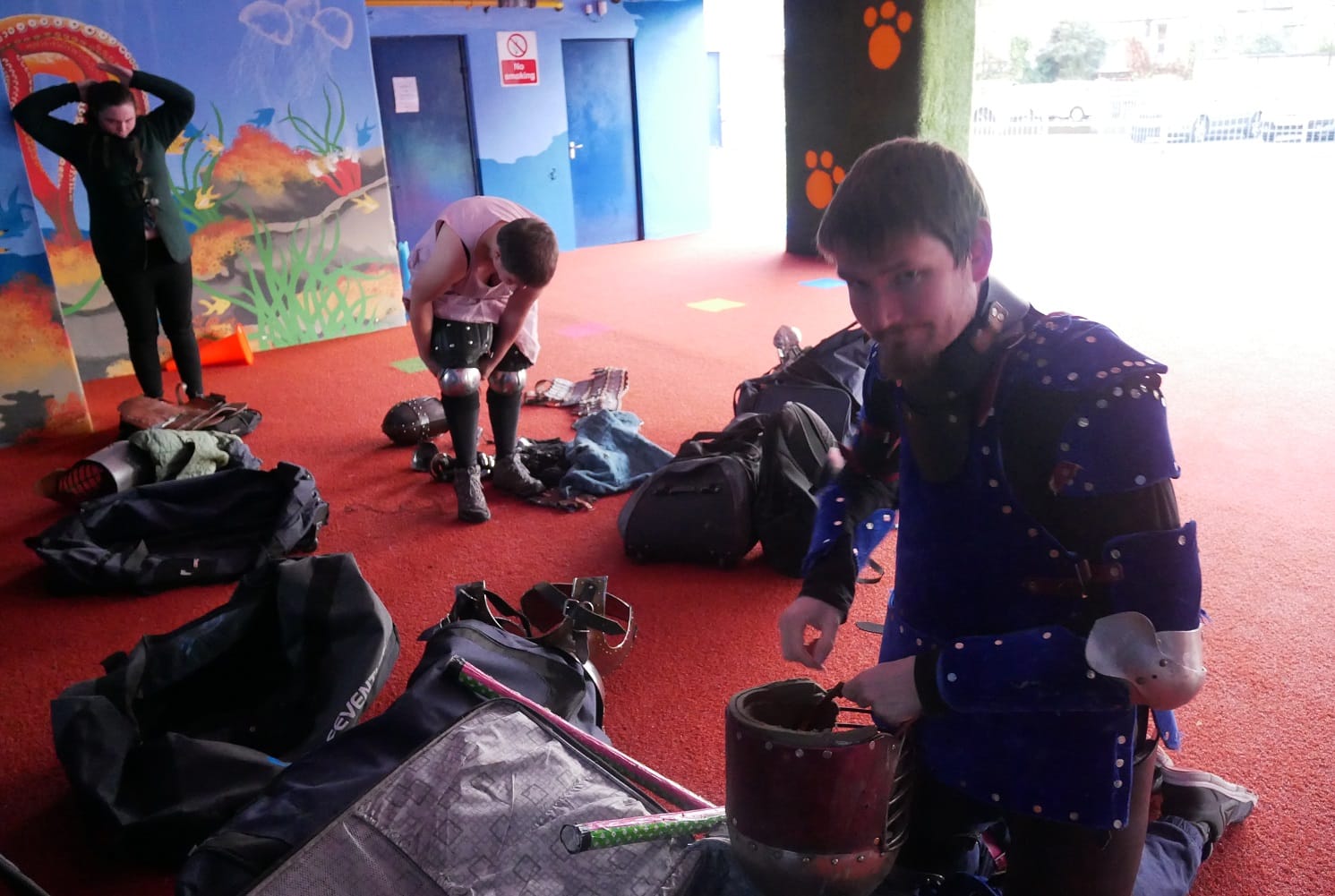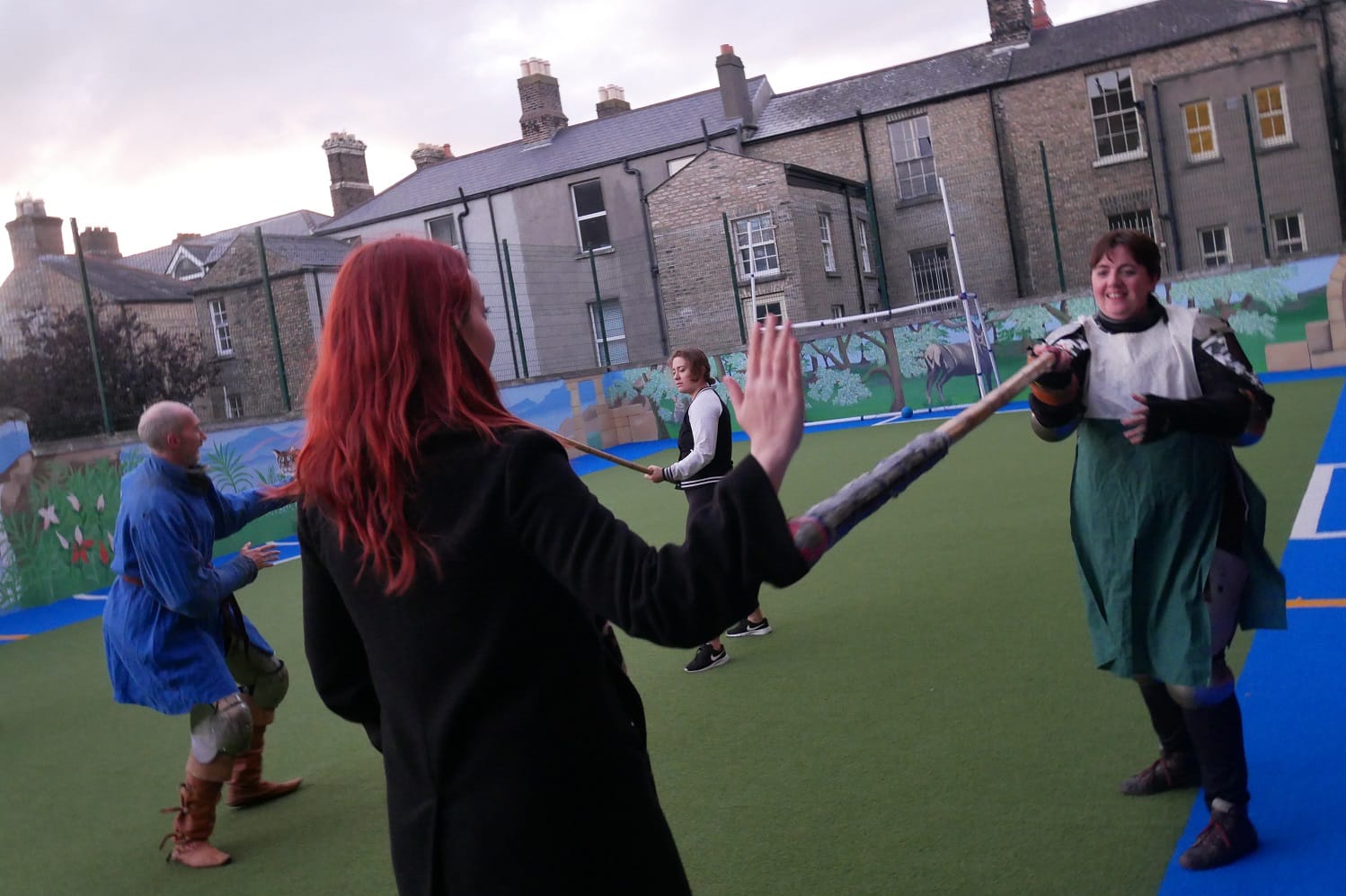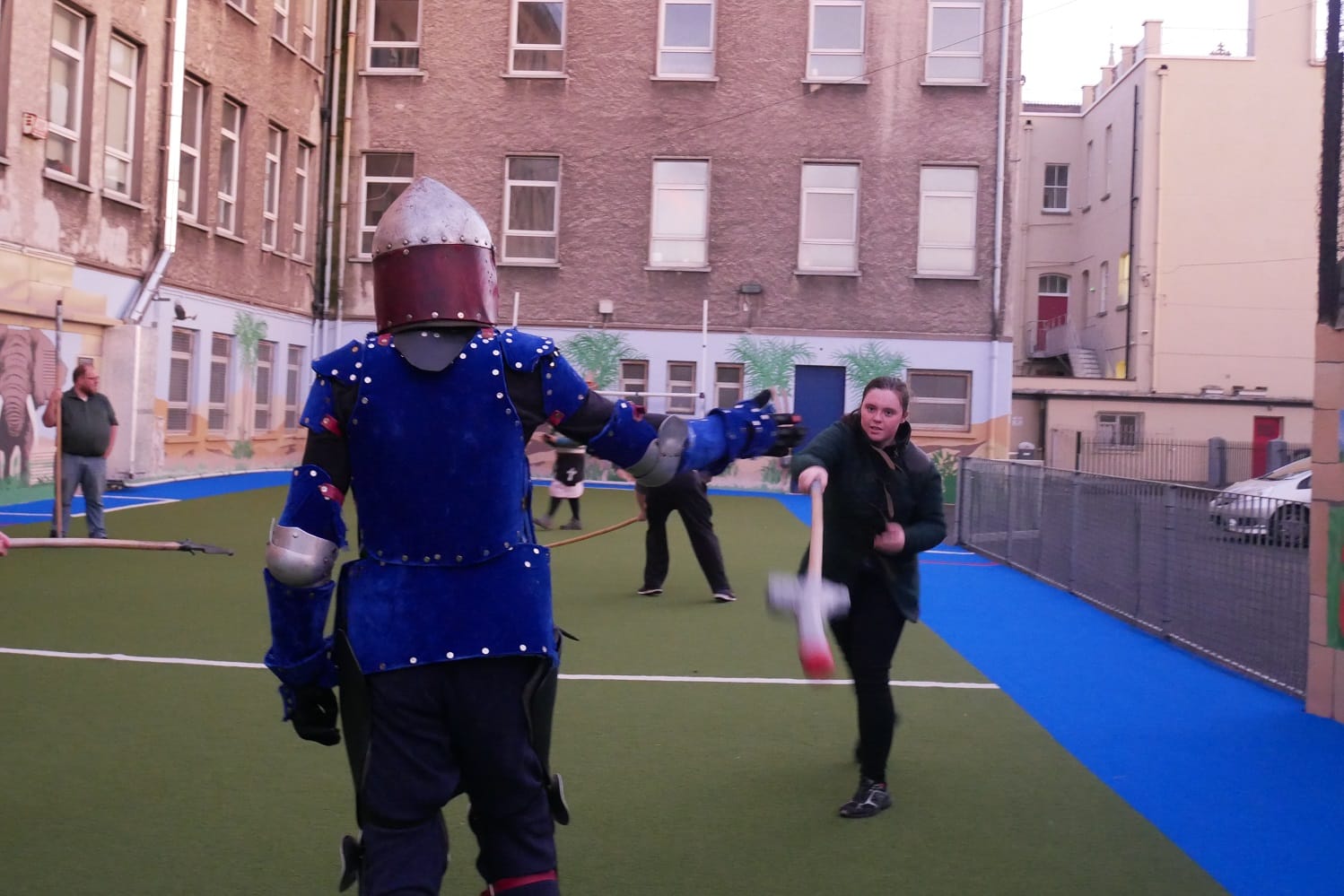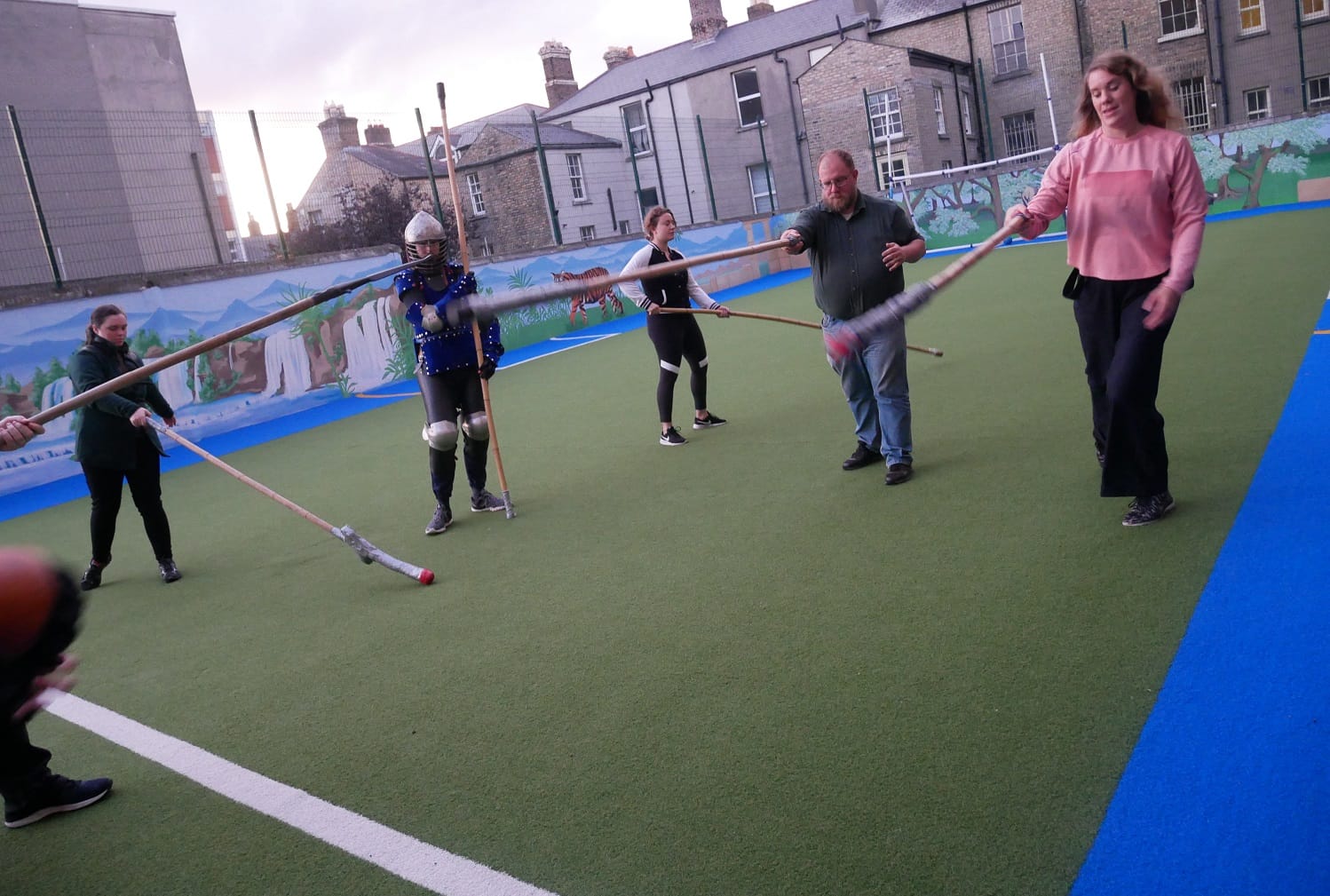What’s the best way to tell area residents about plans for a new asylum shelter nearby?
The government should tell communities directly about plans for new asylum shelters, some activists and politicians say.
Reenacting history goes way beyond dressing up, and deep into ideals of chivalry and honour. “It’s this idea of defending what needs to be defended.”

On the sidelines of the primary school astroturf, Michelle Guinan unpacks 21 kilograms of armour.
She pulls out her steel knee caps and her moulded plastic chest piece, her white and green tunic – and an onion helm.
“A loaner,” says Guinan, or rather, Gytha, of the pointy-topped headgear.
It’s a little big for her. “I have to wear this,” she says, picking up a lining to pad out her head.
A few metres away, Nina Shiel pulls on her trousers, and a pink smock, and fastens her left knee cap, ready to train, not as Nina, but as Agnes – champion of the Principality of Insulae Draconis.
It’s Thursday at 7pm, which is when, each week, the hall or the playground – it depends on the time of year – of the Bunscoil Sancta Maria on Synge Street transforms into a training ground for the chivalrous armoured fighters of Dublin’s branch of the Society for Creative Anachronism.
Or, rather, for members from the shire of Dun in Mara, in the Kingdom of Drachenwald.

Some stumble on the society via the romanticised Victorian stories of the Middle Ages, of the noble exploits of Robin Hood, and the Arthurian tales of honour, Agnes says.
“All the knights and fair damsels and this kind of thing,” she says.
Others from a love of fantasy literature, the Lord of the Rings, Game of Thrones – quest stories too.
It’s a chance to do it, not read about it. “They are kind of intrigued by that,” says Agnes. “That was certainly the case with me.”
The society of history lovers traces its roots to a backyard party in Berkeley, California in 1966. It’s gone global, though.
The shire of Dun in Mara has roughly 40 members. They run archery and fencing sessions, and armoured combat too, of course. They finesse period crafts and arts – ink-making, embroidery, painting and more.
Medieval cooking is Drew Shiel’s, aka Aodh’s, love.
He’s searching all the time for ingredients – at the moment, for the rarer additives in recipes in Nawal Nasrullah’s translation of the medieval Egyptian texts of Treasure Trove of Benefits and Variety at the Table.
He’s hunting for mastic gum, long pepper, and the fruit of a Syrian ash. “Nobody has been able to tell me what it tastes like,” he says.
One grew in the Botanic Gardens in the 1970s, it’s rumoured. “We’ve no idea if the tree is still there,” he says.
Across all activities, members research the finer points of history. “People are constantly chasing down more and more rabbit holes of authenticity and detail and so on and so forth,” he says.
Down to amazing levels of detail, Aodh says. “Getting the right kind of stitches on the inner-lining of a piece of clothing.”
“Well, some people do,” says Agnes.
She’s more into the fighting.

“Here’s another,” says Aodh, holding aloft a second helmet. Not onion-topped this time, but fierce with small eye-holes.
“It’s generically medieval,” he says. “But wedded into our safety standard.”
“It cuts down my range of visibility,” he says.
“Lots and lots of scanning,” says Aidan Barron, aka Aodhan, hovering nearby.
Aodh picks up another – a helm in the style of the Viking era. More authentic, he says – save for the bars over the bottom of the face.
“No gap in these bars is bigger than an inch,” he says. The rattan poles and spears they fight with are fatter.
“Once you have the helm on” – his voice strains and muffles as he pulls it snug over his head – “it will not move”, he says.
Aodh extends one arm out straight, holding a big pole. Then, THWACK.
“I can perfectly safely hit myself” – THWACK – “in the face”, he says, his voice undisturbed – as others chuckle.
A helm can’t be too small either, says Aodhan.
That’s important. He got one stuck on his head once. “It’s hilarious now,” he says, “from five years distance.”
Says Aodh: “It was probably about 10 minutes in total, but it seemed like about half a day I think.”
They were reaching for the Jaws of Life, says Aodhan.

Members don’t just explore the aesthetics and history of an era, says Agnes. It’s about the ideals, too.
About living the ideals of honour, chivalry, and courtesy – the good parts of that anyway, she says. “Or what we see as the good aspects.”
They’ve jettisoned the conceit that women are weaker, says Agnes. “It’s more the fact that in all our dealings we try to be as good people as possible.”
“We try to be courteous to other people, especially in the fighting situations,” she says.
If someone needs help, they help, she says. “Whether it’s practical help or carrying stuff, or listening to somebody’s worries or something like that.”
Says Aodh: “The culture of inclusion is very much how we deal with chivalry and courtesy and so forth.”
Take period titles. They tend to be gendered: lord, lady, count, countess, king, queen.
But there’s work going on to find non-binary titles, too, he says. “Either really obscure historical titles which are gender neutral or, if they’re not available, to make something up.”
Many strive to be as historically authentic as possible, but it yields at times, too.
“We marched in Pride this year, as a group in medieval kit,” says Aodh. “I repainted my shield, which is around here somewhere–”
In the far corner of the pitch, two figures are sparring, one protected with a round shield, painted in colourful stripes.
“–see the rainbow one?” he says.
Says Agnes: “It’s this idea of defending what needs to be defended.”

At one end of the playground, Agnes and Gytha circle each other.
Agnes rocks back slightly on one foot. Gytha does the same.
Gytha swings her sword with her right hand. As it strikes Agnes’ shield, the clunk reverberates around the playground, across the nearby car park and tall concrete flats.
Agnes lunges towards Gytha. She wings at her right leg – dropping her shield to protect herself, too. THWACK. THWACK, and another THWACK.
Gytha dips to get Agnes’s left leg. Good! Agnes drops to the ground, on her knees.
“If you take a good hit of any of the limbs, you lose the use of it,” says Agnes, later.
“I mean, actually, if you were bleeding really heavily from your leg, you wouldn’t be in any condition to fight,” she says. “But happily, we are not.”
Agnes is champion of the principality right now, after winning in one of the tourneys last year. It was her second victory. She sits out the next one, organising it instead.
She’s trained for five years, she says. Sparring at the session once a week. Perfecting the techniques at home for 30 minutes a day. Regular gym visits and runs.
“It’s basically general fitness and the technique,” she says. “I have to put my hands up and say I’ve been slacking a little bit lately.”
Fighting is not so much about victories and losses, says Agnes. “We try to think about how we become better as fighters in general.”
“The ideal again is that you’re trying to focus on your own path rather than comparing yourself with other people,” she says. “That is easier said than done.”
Fighting has given her confidence, she says. “I kind of stopped worrying about things like my weight, looks, all this kind of jazz.”
“I became much more concerned about my fitness and whether I could do things with this body,” she says.
Whether a thwack is recognised or not? That comes back to chivalry again.
If you deliver a convincing blow to the other person and they call it “good”, that’s when you score a point. “You never win, your opponent gives you victory,” she says.
It’s rare for there to be disputes, she says. “There’s a lot of communication between the combatants at all times.”
Gytha says she struggled with that at first. When you’re beaten on the head, screaming, “Good!” rather than an obscenity – being courteous – takes practice, she says.
Get our latest headlines in one of them, and recommendations for things to do in Dublin in the other.